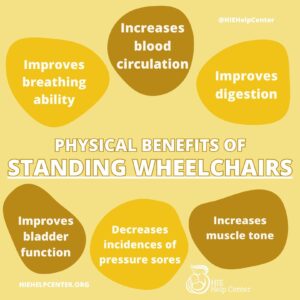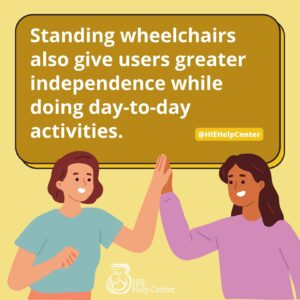Too much time spent sitting can put people at risk for a wide array of health conditions (1, 2). For many, the solution is simple: sit less, and stand and move around more.
Of course, it is more complicated for people who use wheelchairs: even those who use manual wheelchairs and do substantial aerobic exercise and upper-body strength training may experience certain negative effects of excessive sitting. For example, they may develop digestive problems due to pressure on internal organs.
One way for wheelchair users to avoid problems associated with continuous sitting is to use “standing wheelchairs.” Some permit wheeled movement while standing or sitting; others can only be moved while the user is sitting, but can raise the user into an upright, stationary position. Like their ‘traditional’ counterparts, standing wheelchairs are available in both manual and power-operated forms.
Benefits of standing wheelchairs
There are substantial benefits associated with using this type of equipment. Standing wheelchairs and similar devices improve physical well-being. This is backed up by many health measurements, including:
 Breathing ability
Breathing ability- Digestion
- Bladder function
- Blood circulation
- Muscle tone
- Bone mineral density
- Skeletal structure
- Incidence of pressure sores (3)
Moreover, standing wheelchairs give users greater independence when it comes to doing day-to-day activities. For those who don’t live in modified homes, this can be drastically life-altering. For those who do, it can still make it much easier to navigate work, travel, etc.
The ability to engage with others at eye-level also has a lot of social benefits. As Lucy Webster writes in an opinion piece published by the Guardian, “Yes, of course [having a standing wheelchair] means that I can reach things on shelves and whatnot. But it also means I can do typical twentysomething activities such as introduce myself in a noisy environment or even, God forbid, sit at a bar” (4).
Standing wheelchairs come at a high cost
 For all their benefits, standing wheelchairs come with a pretty hefty cost: high-quality powered standing wheelchairs are upwards of $50,000. Manual options are less expensive, but still sell for thousands of dollars (5).
For all their benefits, standing wheelchairs come with a pretty hefty cost: high-quality powered standing wheelchairs are upwards of $50,000. Manual options are less expensive, but still sell for thousands of dollars (5).
Frustratingly, Medicare, Medicaid, and private insurance companies often refuse to cover standing wheelchairs. They may argue that this type of equipment is not medically necessary, too experimental, or a convenience item. Considering the research, however, these claims seem unsubstantiated. Data supporting the health benefits of standing wheelchairs (as well as the costs of not having one) abounds, and this equipment has certainly surpassed the experimental phase.
In her op-ed, Webster writes, “For some disabled people, our wheelchairs are the substitute for our legs. Yet the way we treat disabled people is like asking someone who has broken both legs to pay for the operation to fix the second break – and this from a government that aims to get more of us in work, while remaining indifferent to helping us do so.” She is referring to the U.K.’s national health system (NHS), but the same could be said of governmental programs in the U.S.
Who can help pay?
Some people have found ways to get the government to pay for their standing wheelchair. This may involve writing a very detailed letter explaining why this equipment will help to alleviate their specific health conditions (not just why it is generally useful), and backing it up with statements from their doctors and relevant research papers (6). Persistence helps. Some even contact congressional representatives (5). State-run programs may be easier to persuade than national ones. Others seek assistance from VA hospitals, nonprofits, or religious organizations. They may also turn to crowdsourcing websites like GoFundMe.
It is of course a good thing that people are finding alternative ways to pay for standing wheelchairs, but they shouldn’t have to. In an ideal world, GoFundMe would be used for creative business startups and study abroad trips – not providing something so critically important to physical health, independence, and psychological well being. Governmental agencies and private insurance companies should recognize that this is within their jurisdiction.
Sources:
- Too much sitting: The Population-Health Science of Sedentary Behavior
- Sitting Can Increase Your Risk of Cancer By Up to 66%
- RESNA Position on the Application of Wheelchair Standing Devices
- Wheelchairs have come a long way – shame the NHS hasn’t
- Stand Up and Go with Mobile Standers and Standing Wheelchairs
- Justify It: Standing Frames and Wheelchairs
- The sedentary office: a growing case for change towards better health and productivity.



Been trying to get a stand up wheelchair for 19 years. Now I have a very bad 2 inch deep pressure sore on my backside. why can’t I get any help?
Hello, we will respond to your comment via email soon.